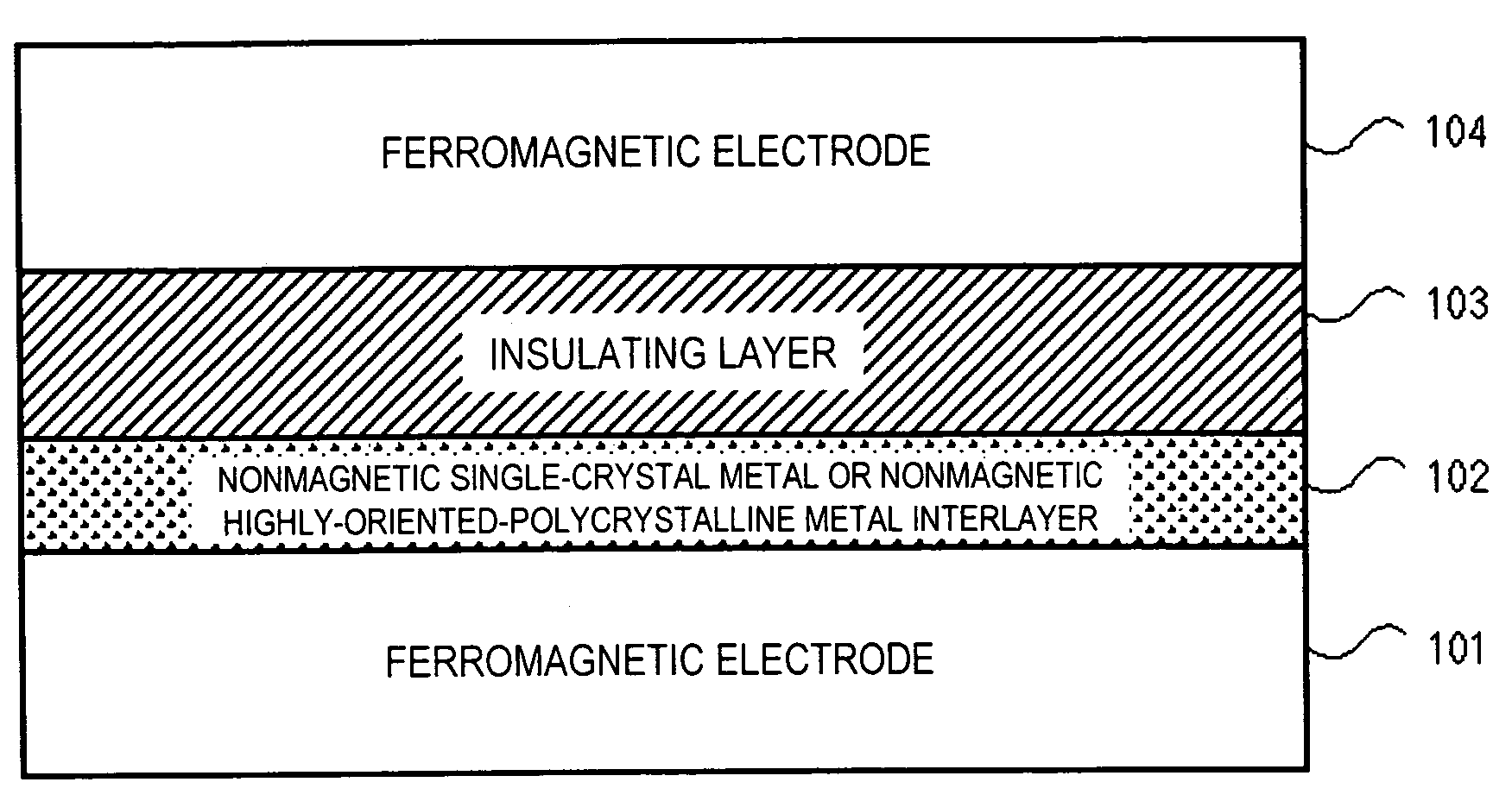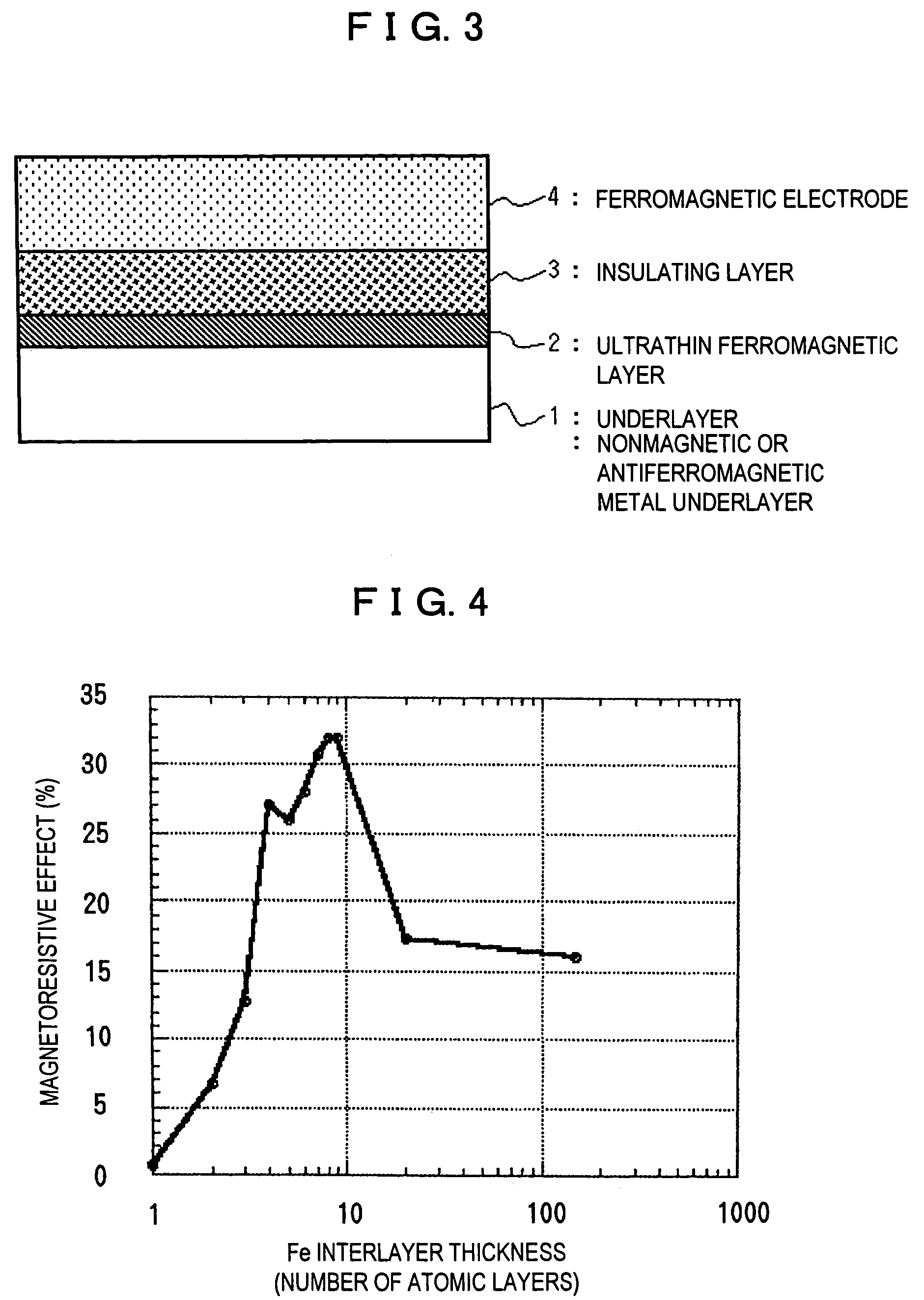Tunnel magnetoresistance element
a tunnel magnetoresistance and element technology, applied in the field of tunnel magnetoresistance elements, can solve the problems of limited spin polarization, unstable surface, and magnetoresistive effect, and achieve the effects of reducing the roughness of the ferromagnetic layer, reducing the magnetostatic coupling between the ferromagnetic layer and the surface roughness
- Summary
- Abstract
- Description
- Claims
- Application Information
AI Technical Summary
Benefits of technology
Problems solved by technology
Method used
Image
Examples
first embodiment
[0059]FIG. 3 is a sectional view of a ferromagnetic tunnel magnetoresistive element according to the first group of the present invention.
[0060]In this figure, reference numeral 1 designates an underlayer formed of, for example, a nonmagnetic metal film or an antiferromagnetic metal film, and reference numeral 2 designates an ultrathin ferromagnetic layer. The thickness of the ultrathin ferromagnetic layer is set in the range of 1 to 15 atomic layers. Reference numeral 3 designates an insulating layer, and reference numeral 4, a ferromagnetic electrode.
[0061]By providing the ultrathin ferromagnetic layer (thickness: 1 to 15 atomic layers) 2 between the underlayer 1 and the insulating layer 3, the spin polarization of the ferromagnetic layer is increased and, resultingly, a large magnetoresistive effect is produced. The spin magnetic moment of Fe atoms isolated in a vacuum is about 4 μB (μB: Bohr magneton) per atom. However, if the Fe atoms enter a crystal to form a body-centered cub...
second embodiment
[0068]FIG. 5 is a sectional view of a ferromagnetic tunnel magnetoresistive element according to the first group of the present invention.
[0069]In the second embodiment, the nonmagnetic or antiferromagnetic metal layer 1 in the first embodiment is replaced with an artificial antiferromagnetic coupling layer 13 including a nonmagnetic or antiferromagnetic interlayer 12 (the composition contains Au, Ag, Cu, Cr, Pt, Pd, Ir, Ru, Rh or an alloy of these metals) formed on a ferromagnetic exchange-coupling layer 11 (the composition contains ferromagnetic metals, such as Fe, Co, Ni, or an alloy of these metals, and other metals, such as Pt, Pd, Ir, and Ru; the thickness is 0.7 to 1.5 times that of the ultrathin ferromagnetic layer 2). Thus, the magnetization of the ultrathin ferromagnetic layer 2 is fixed by the antiferromagnetic exchange coupling with the ferromagnetic exchange-coupling layer 11.
[0070]This structure allows the magnetization of the ultrathin ferromagnetic layer 2 to be fixe...
PUM
| Property | Measurement | Unit |
|---|---|---|
| surface roughness | aaaaa | aaaaa |
| thickness | aaaaa | aaaaa |
| thickness | aaaaa | aaaaa |
Abstract
Description
Claims
Application Information
 Login to View More
Login to View More - R&D
- Intellectual Property
- Life Sciences
- Materials
- Tech Scout
- Unparalleled Data Quality
- Higher Quality Content
- 60% Fewer Hallucinations
Browse by: Latest US Patents, China's latest patents, Technical Efficacy Thesaurus, Application Domain, Technology Topic, Popular Technical Reports.
© 2025 PatSnap. All rights reserved.Legal|Privacy policy|Modern Slavery Act Transparency Statement|Sitemap|About US| Contact US: help@patsnap.com



